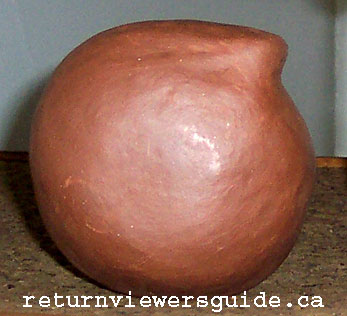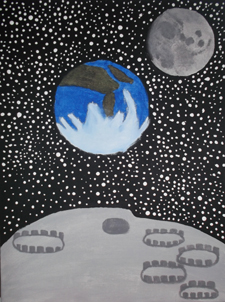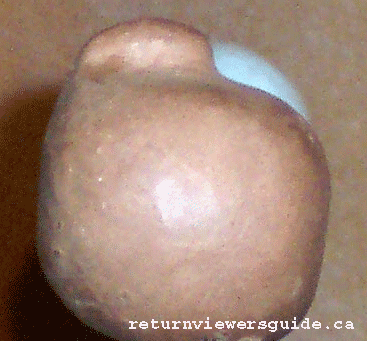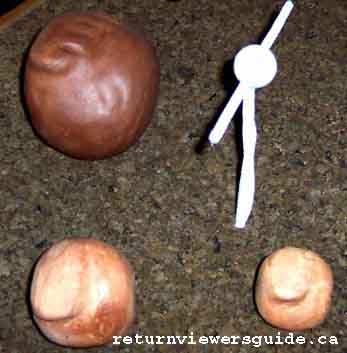- The
Ancient Object returns and rolls down from the region of space above
and to the left of the Moon.
- The
Object first covers the moon's upper left corner as seen from the
earth.
- The
object slowly rolls forward in the direction that it is traveling.
- The
object is traveling at a tremendous speed and is only within the
distance of the Moon's orbit for a very short few minutes, at the
most.
- The
forward rolling object travels towards the viewer's lower right
as it travels down past the Earth's horizon towards and eventually
through the area of space below and beside the Sun.
- The
object's colour matches the brightest areas of the Moon.
|
Image
#1

2005
|
Even though the object crosses at a point well out in front
of the Moon towards the Earth, it also crosses at a point
that is well out from the Earth towards the Moon.
I am mentioning this point because I realize that this point
can help a person to better understand The Basic Flight Path
image.
|
|
- The
crossing angle shown is generally accurate however the left to right
angle shown is very probably slightly high. The top to bottom sink
rate is accurate in general.
- Image
#1, the styrofoam ball is not intended to illustrate the actual
shape of the Object.
- The
pipe cleaner is not 100% straight.
- The
Moon is shown in the background. This image does not illustrate
or attempt to show the actual way the light from the Moon looks
at this point in a return.
- Image
#1 illustrates the location were the Moon's changed light emerges
from over the object's upper right horizon and to the right of the
Object after the total eclipse.
|
| |
|
|
- The
very reflective object is many times brighter than the more distant
dimmer Moon.
- Looking
through a small backyard telescope a normal clear in focus view
of the Moon seems blurry in comparison to the crystal clear very
in focus view of the returning object. Future viewer's will be stunned
and surprised by the clarity of the details that are visible and
very easily seen on the object's surface.
- The
object is incredibly brilliant however in spite of the tremendous
brightness of the object it is not uncomfortable to look at.
|
|
- In
image #1, in general, the scale and or the sizes of the object and
the Moon relative to one another as seen from Earth during the object's
crossing is depicted or shown accurately.
- Image
#2 shows a brownish clay model in front of a white Styrofoam ball.
- There
is a very high probability that the object's raised surface feature
is more centrally located compared to the way my clay models show
the object's raised surface feature located to the left.
|
| |
Image
#3 |
|
- The
object is nearly completely covered with hundreds of craters.
- All
of the craters have what looks like pieces of the object's surface
crust standing vertically around all of the craters.
- Vertically
standing crater rim pieces tower upwards to tremendous heights.
Even the smallest of these craters are actually very large in size
and scale
|
|
- I
modeled the object according to the way I remember it to be. It
may be very possible that the light blending and merging that occurs
between the light from the Moon and the object's right horizon and
especially the object's upper right horizon has caused me to remember
the shape of the object in a slightly distorted to the right fashion.
|
| |
Image
#4 |
|
- The
turning side of the object that partially faces towards the Earth
has no craters.
- All
of the various size craters are exactly the same type of crater.
All of the craters are ringed by vertically standing crater rim
pieces
- I
only saw this one type of crater.
- There
are no craters that look even remotely close to the way that a typical
lunar or Moon, crater looks.
- The
large surface areas between the craters are smooth.
- Some
crease mark indentation lines show similar parallel long curving
line patterns in the area between the craters.
|
|
- The
images on this page do not depict or illustrate the object's or
the Moon's scale or relative sizes with complete 100% accuracy.
- After
modeling the object from the front, position, the way the object
is viewed in image #2, the side profile of the object that is eventually
seen or viewed from the earth is shown in Image #3
- Accurate
brightness and colour's are not depicted or shown anywhere on this
page.
|
| |
Image #5 |
|
- The
object is smaller than the Moon however when the object crosses
between the Earth and Moon, the Moon is completely eclipsed. I say
the object is smaller than the Moon. I have no proof of this and
I realize the object may actually be the same size or even bigger
than the Moon.
- As
the forward rolling object travels towards the viewer's lower right,
the object's large raised surface feature emerges from over the
object's upper horizon and travels towards the viewer.
- The
Moon's light emerges to the right and above the object's upper right
horizon.
- As
the raised feature continues forward and down it develops into a
curving cliff and then gradually, an overhang.
- There
are no craters in the region directly under the overhang.
- The
Sun is located behind the viewer.
- As
the object's raised surface feature continues forward and down the
developing overhang continues to become more pronounced.
- Suddenly
a very black shadow appears located under the overhang.
- The
black spot of the shadow, spreads and continues to spread and thicken
and gather in more of the area up under the overhang as the object's
forward rolling motion continues.
- At
a certain critical point the shadow very suddenly drops or leaps
downwards to the valley floor below, the object's surface, directly
below the overhang.
- The
object itself, although moving and rolling forward, becomes a natural
part of the entire scene. Somehow because of the light blending
and merging between the object's surface and the Moon, incredibly
the object's moving rolling surface becomes part of the entire scene.
The object becomes the left end of the valley.
- Once
the shadow has reached down to the valley floor, directly below
the overhang, the surface of the object, the shadow instantly starts
movement to the right across the surface of the object.
- Also
the shadow travels across the surface of the object away from the
viewer on an angle that steadily increases as the slowly sinking
object continues crossing between the Earth and Moon from the left
to the right.
- The
very fast moving shadow's awesome wave, is a tremendously spectacular
sight that I try to describe in various places within the pages
of this web site.
- First
the main group of tall individual obelisk shaped shadows travel
over and off the object's upper right horizon and then the big black
thick wave of the shadow travels off the object's upper right horizon
into the changed light from the Moon, the ancient valley.
- The
Standing Stone Craters Exist On A Planetary Size And Scale
- Theia,
Is Theia's Core Now The Speeding Object Of The Crossing Down?
- The
Formation Of The Moon
-
The Moon's Ocean Of Storms And The Crossing Object's Powerful Forces
- Lemon
Shaped Moon's Long Internal Axis Matches The Object's Orbital Crossing
Angle
- Lunar
Perigee Alert
 May 27,
2064
May 27,
2064
- Navigation
Page
|

Image #6

Image #7

Image #8

|
- The
object's surface area between the craters has some crease marks.
- As
described the object is nearly completely covered with craters however
no attempt has been made to depict craters or crease marks using
the clay models.
- In
Image #7, I have made no attempt to show the crease marks that are
seen on the object's surface as I try to describe.
- Rotational
frame dragging along with what is very probably a very strong magnetic
field may be two of the factors or forces that may cause the Moon's
light to become so drastically changed in appearance and behavior.
The
Speeding Forward Rolling Object's
Magnetic Field
- The
curving lines that are a part of Image #7, are simply an attempt
to illustrate the overall shape of the object.
- Image
#7 is an attempt to illustrate the way the overall shape of the
object becomes distorted and exaggerated once the Moon's changed
light, (the valley,) is seen to the right, and when the black spot
of the shadow, appears, under the newly formed and slowly developing
evolving overhang.
- The
object's normal, spherical snail shape becomes exaggerated and very
pronounced after the tilting instead of rolling effect, at, the
viewer starts happening, as I try to describe on the Return Viewer's
Guide For Use With A Small Backyard Telescope, page.
- In
Image #8 the changed light from the Moon is shown but only in a
basic and very crude way. Also once again the scale of the various
elements is not depicted accurately.
- To
the right, and the upper right, the Moon's changed light becomes
spread out wide and deep. An incredible expansive sight is seem.
A sight that looks exactly like a valley.
- It
turns out that the object does cause the sight of the ancient valley
of old to occur.
- The
Moon's light does become the famous ancient valley as every viewer
will be seeing for themselves, very soon.
UNLESS
CLEARLY STATED OTHERWISE
The images on this website are free to use for non-commercial purposes.
If you use our images please do not remove the website address;
www.returnviewersguide.ca
Please provide a link to this website.
This is all that we ask in return for the non-commercial use of
our images. Terms
Of Use
Thanks
D.S.W.***
|













